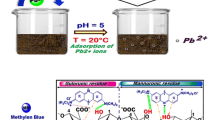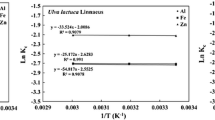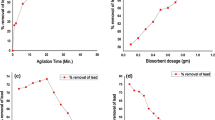Abstract
Present study focused on the effective utilization of red algae (Rhodophyta sp.) towards removal of fluoride from contaminated medium by varying the operating variables (pH, adsorbent dose, initial concentration, contact time and temperature) and screen out the best condition for removal of fluoride through response surface optimization technique. The algal biomass was characterized by various analytical instruments, such as scanning electron microscopy (SEM), Fourier transform infrared (FTIR) spectrometry and point of zero charge (pHZPC). Results revealed that the equilibrium data nicely fitted with Langmuir model with biosorption capacity 5.484 mg g−1. The optimized values was screed from response surface methodology as initial concentration, temperature, dose and contact time are 9.77 mg L−1, 302.63 K, 10.8 g L−1, and 23.17 min, respectively. Finally, optimized condition was applied for removal of fluoride from fluoride contaminated villages of Birbhum district and average 80% fluoride was removed. The exhausted adsorbent was regenerated (95%) using 0.1 N NaOH solution. Therefore, present finding suggest that the red algae (Rhodophyta sp.) could be an excellent biosource for decontamination of fluoride from underground water.






Similar content being viewed by others
Abbreviations
- APHA:
-
American Public Health Association
- ANOVA:
-
Analysis of variance
- ANN:
-
Artificial neural network
- EDTA:
-
Ethyaldiamine tetra acetic acid
- FTIR:
-
Fourier transform infrared
- HCl:
-
Hydrocholric acid
- pHZPC :
-
Point of zero charge
- RSM:
-
Response surface methodology
- SEM:
-
Scanning electron microscopy
- WHO:
-
World Health Organization
References
Adewuyi A (2020) Chemically modified biosorbents and their role in the removal of emerging pharmaceutical waste in the water system. Water 12(6):1551–1560
Akafu T, Chimdi A, Gomoro K (2019) Removal of fluoride from drinking water by sorption using diatomite modified with aluminum hydroxide. J Anal Methods Chem 3:4831926
Al-Homaidan AA, Al-Houri HJ, Al-Hazzani AA, Elgaaly G, Moubayed NMS (2014) Biosorption of copper ions from aqueous solutions by Spirulina platensis biomass. Arab J Chem 7:57–62
Amin F, Talpur FN, Balouch A (2015) Biosorption of fluoride from aqueous solution by white—rot fungus Pleurotus eryngii ATCC 90888. Environ Nanotechnol Monit Manag 3:30–37
Angelin A, Kalpana M, Govinda K, Kavitha S (2021) Characterizations and fluoride adsorption performance of wattle humus biosorbent. Environ Sci Pollut Res. https://doi.org/10.1007/s11356-021-14864-9
Annadurai ST, Arivalagan P, Sundaram R, Mariappan R, Munusamy AP (2019) Batch and column approach on biosorption of fluoride from aqueous medium using live, dead and various pretreated Aspergillus niger (FS18) biomass. Surf Interfaces 15:60–69
Araga R, Soni S, Sharma CS (2017) Fluoride adsorption from aqueous solution using activated carbon obtained from KOH-treated jamun (Syzygium cumini) seed. J Environ Chem Eng 5:5608–5616
Bayuo J, Abukari MA, Pelig-Ba KB (2020) Desorption of chromium(VI) and lead(II) ions and regeneration of the exhausted adsorbent. Appl Water Sci 10:1–6
Bharali RK, Bhattacharyya KG (2015) Biosorption of fluoride on Neem (Azadirachta indica) leaf powder. J Environ Chem Eng 3:662–669
Bhatnagar M, Bhatnagar A, Jha S (2002) Interactive biosorption by microalgal biomass as a tool for fluoride removal. Biotechnol Lett 24:1079–1081
Bhattacharjee C, Dutta S, Saxena VK (2020) A review on biosorptive removal of dyes and heavy metals from wastewater using watermelon rind as biosorbent. Environ Adv 2:100007
Bilal M, Shah JA, Ashfaq T et al (2013) Waste biomass adsorbents for copper removal from industrial wastewater—a review. J Hazard Mater 263:322–333
Bilal M, Rasheed T, Sosa-Hernández JE et al (2018) Biosorption: an interplay between marine algae and potentially toxic elements—a review. Mar Drugs 16:65
Bronckers ALJJ, Lyaruu DM, DenBesten PK (2009) The impact of fluoride on ameloblasts and the mechanisms of enamel fluorosis. J Dent Res 88:877–893
Cai P, Zheng H, Wang C et al (2012) Competitive adsorption characteristics of fluoride and phosphate on calcined Mg–Al–CO3 layered double hydroxides. J Hazard Mater 213–214:100–108
Chattoraj S, Mondal NK, Sen K (2018) Removal of carbaryl insecticide from aqueous solution using eggshell powder: a modeling study. Appl Water Sci 8:163
Das B, Banerjee S, Raul PK, Devi RR, Umlong IM, Talukdar AK, Dwivedi SK (2021a) Removal of fluoride from water using mesoporous MCM-41: an optimization approach using response surface methodology (RSM). Adv Nanopart 10:95–114
Das L, Das P, Bhowal A, Bhattacharjee C (2021b) Enhanced biosorption of fluoride by extracted nanocellulose/polyvinyl alcohol composite in batch and fixed-bed system: ANN analysis and numerical modeling. Environ Sci Pollut Res 28:47107–47125
Deng S, Chen Y (2019) A study by response surface methodology (RSM) on optimization of phosphorus adsorption with nano spherical calcium carbonate derived from waste. Water Sci Technol 79:188–197
Dobaradaran S, Ali Zazuli M, Keshtkar M, Noshadi S, Khorsand M (2016) Biosorption of fluoride from aqueous phase onto Padina sanctae crucis algae: evaluation of biosorption kinetics and isotherms. Desalin Water Treat 57:28405–28416
El-Said GF, El-Sadaawy MM, Aly-Eldeen MA (2017) Adsorption isotherms and kinetic studies for the defluoridation from aqueous solution using eco-friendly raw marine green algae. Ulva Lactuca Environ Monit Assess 190:14
Everett ET (2011) Fluoride’s effects on the formation of teeth and bones, and the influence of genetics. J Dent Res 90:552–560
Gai W-Z, Deng Z-Y (2021) A comprehensive review of adsorbents for fluoride removal from water: performance, water quality assessment and mechanism. Environ Sci: Water Res Technol 7:1362–1386
Ghosh SB, Mondal NK (2019) Application of Taguchi method for optimizing the process parameters for the removal of fluoride by Al-impregnated Eucalyptus bark ash. Environ Nanotechnol Monit Manage 11:100206
Ghosh SB, Bhaumik R, Mondal NK (2016) Optimization study of adsorption parameters for removal of fluoride using aluminium-impregnated potato plant ash by response surface methodology. Clean Techn Environ Policy 18:1069–1083
Gopal V, Elango KP (2007) Equilibrium, kinetic and thermodynamic studies of adsorption of fluoride onto plaster of Paris. J Hazad Mater 141:98–105
Habuda-Stanić M, Ergović Ravančić M, Flanagan A (2014) A review on adsorption of fluoride from aqueous solution. Materials (basel) 7:6317–6366
Hadiyanto H, Khoironi A, Dianratri I (2021) Interactions between polyethylene and polypropylene microplastics and Spirulina sp. microalgae in aquatic systems. Heliyon 7:e07676
Hiremath PG, Theodore T (2018) Modelling of fluoride biosorption by calcium-doped algae using response surface methodology. Indian Chem Eng 60:37–57
Joshi V, Le Gallo M, Haefeli S (2020) Accurate deep neural network inference using computational phase-change memory. Nat Commun 11:2473
Kumar PJS (2021) Groundwater fluoride contamination in Coimbatore district: a geochemical characterization, multivariate analysis, and human health risk perspective. Environ Earth Sci 80:2–14
Kumar M, Puri A (2012) A review of permissible limits of drinking water. Indian J Occup Environ Med 16:40–44
Lee JI, Hong SH, Lee CG (2021) Fluoride removal by thermally treated egg shells with high adsorption capacity, low cost, and easy acquisition. Environ Sci Pollut Res 28:35887–35901
Lim HR, Choo CM, Chong CH, Wong V-L (2021) Optimization studies for water defluoridation with two-stage coagulation processes using new industrial-based chemical coagulants. J Water Process Eng 42:102179
López-Luna J, Ramírez-Montes LE, Martinez-Vargas S et al (2019) Linear and nonlinear kinetic and isotherm adsorption models for arsenic removal by manganese ferrite nanoparticles. SN Appl Sci 1:950
Magsi SK, Kandhar IA, Brohi ROZ, Channa A (2019) Removal of metals from water using fish scales as a bioadsorbent. AIP Conf Proc 2119:020023
Mahmood T, Saddique MT, Naeem A et al (2011) Comparison of different methods for the point of zero charge determination of NiO. Ind Eng Chem Res 50:10017–10023
Mihayo D, Vegi MR, Vuai SAH (2021) Defluoridation of aqueous solution using thermally activated biosorbents prepared from Adansonia digitata fruit pericarp. Adsorp Sci Technol 12:1–16
Mohamed WÙSE-D, Hamad MTMH, Kamel MZ (2020) Application of statistical response surface methodology for optimization of fluoride removal efficiency by Padina sp. alga. Water Environ Res 92:1080–1088
Mondal NK, Kundu M (2016) Biosorption of fluoride from aqueous solution using lichen and its Ca-pretreated biomass. Water Conserv Sci Eng 1:143–160
Mondal NK, Das B, Bhaumik R, Roy P (2012) calcareous soil as a promising adsorbent to remove fluoride from aqueous solution: equilibrium, kinetic and thermodynamic study. J Mod Chem Chem Technol 3:1–21
Mondal NK, Basu S, Sen K, Debnath P (2019a) Potentiality of mosambi (Citrus limetta) peel dust toward removal of Cr(VI) from aqueous solution: an optimization study. Appl Water Sci 116:1–13
Mondal NK, Ghosh P, Sen K et al (2019b) Efficacy of onion peel towards removal of nitrate from aqueous solution and field samples. Environ Nanotechnol Monit Manag 11:100222
Moran Ayala LI, Paquet M, Janowska K et al (2018) Water defluoridation: nanofiltration vs membrane distillation. Ind Eng Chem Res 57:14740–14748
Mukherjee S, Mondal M, Banerjee S, Halder G (2017) Elucidation of the sorptive uptake of fluoride by Ca2+-treated and untreated algal biomass of Nostoc sp. (BTA394): isotherm, kinetics, thermodynamics and safe disposal. Process Saf Environ 107:334–345
Pavasant P, Apiratikul R, Sungkhum V et al (2006) Biosorption of Cu2+, Cd2+, Pb2+, and Zn2+ using dried marine green macroalga Caulerpa lentillifera. Bioresour Technol 97:2321–2329
Pigatto RS, Franc DSP, Netto MS, Carissimi ÃI, Oliveira LFS, Jahn SL, Dotto GL (2020) An eco-friendly and low-cost strategy for groundwater defluorination: adsorption of fluoride onto calcinated sludge. J Environ Chem Eng 8:1–10
Radić J, Bralić M, Kolar M, Genorio B, Prkić A, Mitar I (2020) Development of the new fluoride ion-selective electrode modified with FexOy nanoparticles. Molecules 25:1–13
Rajkumar S, Murugesh S, Sivasankar V et al (2019) Low-cost fluoride adsorbents prepared from a renewable biowaste: syntheses, characterization and modeling studies. Arab J Chem 12:3004–3017
Ramanaiah SV, Venkata Mohan S, Sarma PN (2007) Adsorptive removal of fluoride from aqueous phase using waste fungus (Pleurotus ostreatus 1804) biosorbent: kinetics evaluation. Ecol Eng 31:47–56
Roy TK, Mondal NK (2019) Potentiality of Eichhornia shoots ash towards removal of Congo red from aqueous solution: isotherms, kinetics, thermodynamics and optimization studies. Groundw Sustain Dev 9:100269
Sadhukhan B, Mondal NK, Chattoraj S (2016) Optimisation using central composite design (CCD) and the desirability function for sorption of methylene blue from aqueous solution onto Lemna major. Karbala Int J Mod Sci 2:145–155
Sahu N, Bhan C, Singh J (2021) Removal of fluoride from an aqueous solution by batch and column process using activated carbon derived from iron infused Pisum sativum peel: characterization, isotherm, kinetics study. Environ Eng Res 26:1–11
Sen K, Mondal NK (2021) Statistical optimization of glyphosate adsorption by silver nanoparticles loaded activated carbon: kinetics, isotherms and thermodynamics. Environ Nanotechnol Monit Manag 16:100547. https://doi.org/10.1016/j.enmm.2021.100547
Sen K, Datta JK, Mondal NK (2019) Glyphosate adsorption by Eucalyptus camaldulensis bark-mediated char and optimization through response surface modeling. Appl Water Sci 9:162–170
Sen K, Datta JK, Mondal NK (2020) Box–Behnken optimization of glyphosate adsorption on to biofabricated calcium hydroxyapatite: kinetic, isotherm, thermodynamic studies. Appl Nanosci 11:687–697
Sharada S, Pavani Y (2020) Removal of fluoride from synthetic water by using banana as low cost adsorbent. J Emerg Technol 7:821–839
Singh R, Bhateria R (2020) Optimization and experimental design of the Pb2+ adsorption process on a nano-Fe3O4-based adsorbent using the response surface methodology. ACS Omega 20:28305–28318
Su H, Wang J, Liu J (2019) Geochemical factors controlling the occurrence of high-fluoride groundwater in the western region of the Ordos basin, northwestern China. Environ Poll 252:1154–1162. https://doi.org/10.1016/j.envpol.2019.06.046
Suchkova GG, Maklakov LI (2009) Amide bands in the IR spectra of urethanes. Vib Spectrosc 51:333–339
Tangestani M, Naeimi B, Dobaradaran S (2021) Biosorption of fluoride from aqueous solutions by Rhizopus oryzae: isotherm and kinetic evaluation. Environ Prog Sustain Energy 1:13725
Tüzün İ, Bayramoğlu G, Yalçın E et al (2005) Equilibrium and kinetic studies on biosorption of Hg(II), Cd(II) and Pb(II) ions onto microalgae Chlamydomonas reinhardtii. J Environ Manag 77:85–92
Vahabisani A, An C (2021) Use of biomass-derived adsorbents for the removal of petroleum pollutants from water: a mini-review. Environ Syst Res 10:25–31
Venkata Mohan S, Ramanaiah SV, Rajkumar B, Sarma PN (2007) Removal of fluoride from aqueous phase by biosorption onto algal biosorbent Spirogyra sp.-IO2: sorption mechanism elucidation. J Hazard Mater 141:465–474
Verma VK, Tewari S, Rai JPN (2008) Ion exchange during heavy metal bio-sorption from aqueous solution by dried biomass of macrophytes. Bioresour Technol 99:1932–1938
Viswanathan N, Meenakshi S (2008) Enhanced fluoride sorption using La(III) incorporated carboxylated chitosan beads. J Colloid Interface Sci 322:375–383
Viswanathan N, Sundaram CS, Meenakshi S (2009) Removal of fluoride from aqueous solution using protonated chitosan beads. J Hazard Mater 161:423–430
Wambu EW, Onindo CO, Ambusso W, Muthakia GK (2013) Removal of fluoride from aqueous solutions by adsorption using a siliceous mineral of a Kenyan Origin. Clean: Soil, Air, Water 41:340–348
Wan K, Huang L, Yan J, Ma B, Huang X, Luo Z, Xiao T (2021) Removal of fluoride from industrial wastewater by using different adsorbents: a review. Sci Tot Environ 773:1–20
Yadav AK, Abbassi R, Gupta A, Dadashzadeh M (2013) Removal of fluoride from aqueous solution and groundwater by wheat straw, sawdust and activated bagasse carbon of sugarcane. Ecol Eng 52:211–218
Yahfoufi ZA, Bai D, Khan SN (2020) Glyphosate induces metaphase II oocyte deterioration and embryo damage by zinc depletion and overproduction of reactive oxygen species. Toxicology 439:152466
Zhang Y, Huang K (2019) Grape pomace as a biosorbent for fluoride removal from groundwater. RSC Adv 9:7767–7776
Zúñiga-Muro NM, Bonilla-Petriciolet A, Mendoza-Castillo DI et al (2017) Fluoride adsorption properties of cerium-containing bone char. J Fluor Chem 197:63–73
Acknowledgements
Authors express their sincere thanks to all the faculty members of Environmental Science, The University of Burdwan, Burdwan, West Bengal. Authors also like thanks to all the technical staff of Chemistry Department for their help and cooperation.
Funding
This work funded by the University of Burdwan, Burdwan, WB as M.Sc dissertation work (M.Sc/Disser/2013-2015(2), dated 10.02.2015), and DST Government of India in the form of FIST project (SR/FST/ESI-141/2015, dated 25.07.2016).
Author information
Authors and Affiliations
Contributions
Entire research design and manuscript was written by NKM and RB and PD were conducted the entire laboratory work and Modelling work was performed by KS.
Corresponding author
Ethics declarations
Conflict of interest
Authors declared that they have no any conflict of interest for publication of the present manuscript.
Additional information
Publisher's Note
Springer Nature remains neutral with regard to jurisdictional claims in published maps and institutional affiliations.
Supplementary Information
Below is the link to the electronic supplementary material.
Rights and permissions
About this article
Cite this article
Mondal, N.K., Bhaumik, R., Sen, K. et al. Adsorption of fluoride in aqueous solutions using saline water algae (Rhodophyta sp.): an insight into isotherm, kinetics, thermodynamics and optimization studies. Model. Earth Syst. Environ. 8, 3507–3521 (2022). https://doi.org/10.1007/s40808-021-01320-3
Received:
Accepted:
Published:
Issue Date:
DOI: https://doi.org/10.1007/s40808-021-01320-3




